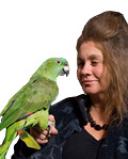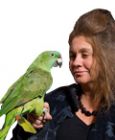Photo credit: Pamela Winter, courtesy of United Poultry Concerns We are what we think.
All that we are arises with our thoughts.
With our thoughts we make the world.

Photo credit: Pamela Winter, courtesy of United Poultry Concerns
We are what we think.
All that we are arises with our thoughts.
With our thoughts we make the world.
Speak or act with an impure mind
And sorrow will follow you.
Speak or act with a pure mind
And happiness will follow you as your
shadow, unshakeable. —The Buddha
This past month the media reported that Ms. Amber Hansen's art project, The Story of Chickens: A Revolution, was in violation of Lawrence, Kansas ordinances that protect animals from being harmed or killed within city limits. Ms. Hansen is a resident lecturer at the University of Kansas.
At first glance, the city appears to be censoring artistic expression, some of which, historically, whether in prose, music, or paint, has catalyzed liberation and justice. However, in this case, we are horrified to discover not only what Ms. Hansen considers "art," but also what her inspiration would create. [1] Over a several week period, the artist proposed to display five chickens around town in a coop, then publically slaughter the birds and serve them up to the community.
According to Ms. Hansen,
By building a relationship with the birds, the project will transform the contemporary view of chickens as merely "livestock" to the beautiful and unique creatures they are, while promoting alternative and healthy processes of caring for them. [2]
She asks us to believe that confining five sentient beings against their will, in cages vulnerable to anything and anyone, summarily executing, eviscerating, butchering, and eating them at a community potluck comprises "building a relationship with ... beautiful and unique creatures" that "transform[s] the contemporary view of chickens as livestock." This maze of twisted illogic out-competes any conceivable Orwellian doublespeak. Tragically, it epitomizes much of the perverse discourse surrounding nonhuman animals—and the dissociated way we imagine and live life.
Psychiatrist Robert Jay Lifton described dissociative realities in his seminal work, The Nazi Doctors. [3] He called the mechanism that maintains conflicting ethical worlds of existence, "doubling." Doubling falls within the same category as dissociation, splitting, and numbing that are mental methods to have your cake and eat it too, or in the case of Ms. Hansen, have your chickens and eat them too.
Photo by Mercy For Animals, courtesy of United Poultry Concerns
Split-world living is accomplished by creating two functioning, interdependent wholes within our self. These twin selves are independent, yet connected. For example, the "Auschwitz self" was autonomous and free of the moral standards that applied outside the camp. By switching over to his other "humane" self after "work," the doctor could live a parallel untarnished life as a principled professional and family man. While the "camp self" performed selections for the gas chambers, the humane self played congenial host and father outside the prison—a psychological no-lose proposition.
With doubling, the two selves live like conjoined twins in their respective environments, neatly housed in the same person. An individual can claim to be an artist seeking to enlighten humanity on one hand, while at the same time committing atrocities in the name of said art, with no sense of ethical or perceptual incongruity. Doubling permits us to imagine one thing, do another ethically thing in conflict, then regard the diametrically opposing concepts and actions as related and congruent. By this logic, one can assert that chickens are "beautiful unique birds," butcher and eat them, and refer to the experience as a "healthy process of caring for them."
Ms. Hansen is hardly alone in this double logic. Dualism, and its progeny, experience-by-proxy technology, enables a Through-the-Looking-Glass form of ethics. We blithely watch intimate graphic violence of rape and mutilation in Iraq, then, within milliseconds, change channels to an exercise program where Lycra-adorned athletes work to stay slim. We may experience a brief contrail of ethical discomfort, but this evaporates in the rarified atmosphere of normalcy. [4]
Culturally-condoned doubling causes us to recoil in surprise when learning that a seasoned U.S. soldier, trained to kill and from "the most troubled base in the U.S. military," went out and slaughtered sixteen Afghan civilians. [5] After nearly a century of scientific and medical documentation of the causes and symptoms of Post-Traumatic Stress Disorder (PTSD), we are nonetheless bewildered by what he is alleged to have done. We are trigger-ready to mete out justice to a man who has been paid by our own monies and votes to learn how to double, and to kill.
Our doubling culture is no accident. It runs on parallel worlds for a very concrete reason: profit. Ms. Hansen builds her livelihood as artiste. Let us not forget that no less than three institutions, the Andy Warhol Foundation for Visual Arts, the Charlotte Street Foundation, and Kansas' University Spencer Museum of Art, are cited as funders for the project. [1] Ms. Hansen was paid to terrorize, demean and kill her victims to celebrate "art." She and countless others who profit from institutionalized oppression and violence make a living, gratis, doubling. [4]
There is no mystery to doubling. What was engendered writ large in the camps eighty years ago now comprises the commonplace of everyday life. It inspired the psychological architecture that provides us comfortable living at the expense of victims who do not succumb to the convenience of raw survival. [6]

Photo credit: The Animals Voice
Chickens refuse to double. [7] They are too sensitive, too aware of what the Buddha taught. They speak and act with a pure mind despite what we do to them. Let us throw off doubling's seduction and take a page out of the book of chickens to indeed create a Center for Transcendental Poultry—not in the vulgarity of sarcastic fear [8], but out of a true commitment to honesty and compassion and an embrace of a unified reality. [9] [10]
Literature Cited
[1] Blakeborough, J. 2012. Animal activists celebrate as Lawrence blocks chicken art project. The Kansas City Star, http://www.kansascity.com/2012/02/28/3457554/lawrence-blocks-chicken-ar…
[2] New York Daily News. 2012. Kansas officials halt artist's plan to slaughter chickens in public. New York Daily News; http://www.nydailynews.com/news/national/kansas-officials-haltartist-pl…
[3] Lifton, R.J. 1986. The Nazi Doctors: Medical Killing and the Psychology of Genocide, New York: Basic.
[4] Bradshaw, G.A. 2009. Elephants on the edge: What animals teach us about humanity. New Haven: Yale University Press.
[5] Flock, E. 2012. Afghanistan shooting suspect came from Lewis-McChord, ‘most troubled base in the military', The Washington Post
http://www.washingtonpost.com/blogs/blogpost/post/afghanistan-shooting-… military/2012/03/12/gIQApIdJ7R_blog.html
[6] Bradshaw, G.A. in press. Living out of our minds. in P. Kahn and P. Hasbach (eds). Rediscovery of the Wild. MIT Press.
[7] Potts, A. 2012. Chicken. Rekation Books.
[8] Sanchez, M. 2012. Artist's message flew coop amid Lawrence chicken debate
http://www.kansascity.com/2012/02/29/3460440/artists-message-flew-coop-…
[9] United Poultry Concerns. 2012. http://www.upc-online.org/
[10] Vine Sanctuary, 2012. http://vine.bravebirds.org




